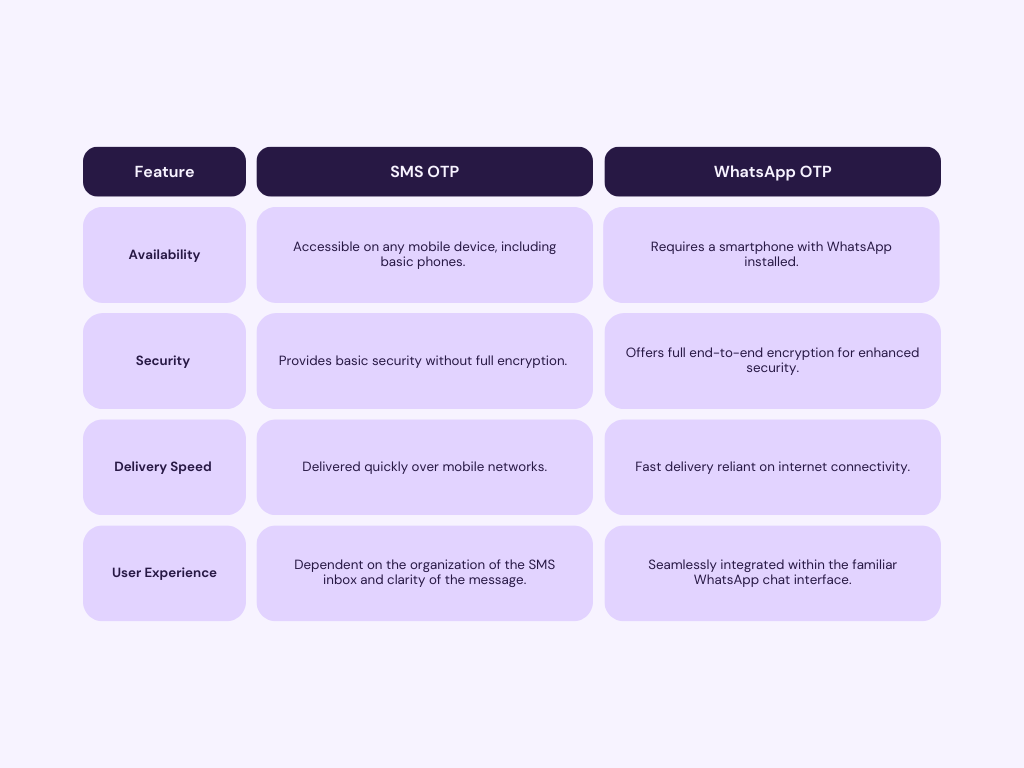When it comes to keeping online accounts secure, one-time passwords (OTPs) are crucial. Many businesses depend on OTPs to ensure only authorized users access their accounts. Typically, these messages are sent via SMS, but they can also be sent through WhatsApp. With WhatsApp OTPs, a unique passcode is sent to a user’s registered WhatsApp phone number. It’s a quick, easy, and secure way for them to verify their identity and carry out transactions.
In this blog, we’ll explore how OTPs work on WhatsApp, guide you through how to set up your business to send them, and then delve into several enterprise use cases. Let’s get started!
Understanding WhatsApp OTP
WhatsApp OTPs are used as a form of two-factor authentication (2FA) to verify a user’s identity during account logins, transactions, or other sensitive actions. Using WhatsApp to send these messages adds an extra layer of security compared to other channels, ensuring end-to-end encryption, high delivery rates, and cost-effectiveness.
WhatsApp One-Time Password Example
A WhatsApp OTP is a unique code sent to a user’s phone number. It expires after one use or a short time, adding security to the login process. Whether you or your customer are checking a bank balance or buying something online, an OTP message sent via WhatsApp can help keep personal information safe from hackers and cyber threats.
And the best part? For the user, the process is straightforward and instant. Instead of having to jump through hoops to prove who you are, you just get a code on WhatsApp that you can use to confirm your identity. Plus, it’s free for users to receive WhatsApp OTPs. Businesses pay the authentication messaging price, but for the user it doesn’t cost anything.
OTP WhatsApp vs. SMS
As many as 93% of global enterprises use some type of SMS OTP verification. That’s a lot! So, you may be thinking that the only difference between SMS and WhatsApp OTPs is that one is sent as a text message and the other via a WhatsApp chat. But there’s more to it than that. Let’s break down the differences.

Understanding these differences can help you make informed choices about which OTP authentication method suits your needs – and your customers’ needs – best.
Still on the fence about which route to take to reach all your customers? Here’s a tip: With a Conversation API, sending WhatsApp OTPs is scalable because it offers fallback verification to SMS or another preferred messaging channel.
How to Send a WhatsApp OTP
Sending a WhatsApp OTP is simple, but you’ll need a WhatsApp Business Platform account to do it. That’s because you can only send OTPs using an Authentication template in WhatsApp Business API. If you’re using the free WhatsApp Business App, unfortunately you won’t be able to send OTPs through WhatsApp.
As an enterprise, your best bet to send OTPs via WhatsApp is to choose a WhatsApp Business Solution provided by a Business Service Provider (BSP). It’s the easiest way to access an API to send OTPs through WhatsApp, and setup is a breeze. Plus, using a BSP offers a few added perks – like high messaging throughput, automatic fallback to SMS if WhatsApp connection is lost or the recipient doesn’t have an active WhatsApp account, and options to integrate other channels like contact centers, chatbots, and more. To get started, check out this detailed guide on WhatsApp Business API.
Here’s a quick and easy three-step process to get started:
- Set up a Meta Business Manager account: First and foremost, you’ll need to set up a Meta Business Manager account. Here, you’ll fill in information about your business and will be able to add other people and assets to your account.
- Sign up for a WhatsApp Business Platform account: Once you have your Meta Business Manager account, you can set up a WhatsApp Business Platform account. Follow the instructions to create an account and configure the necessary settings.
- Submit your Authentication message templates to WhatsApp for approval: To send any business-initiated conversations via WhatsApp (like one-time passwords), you must have subscriber opt-in and approved templated messages in WhatsApp Business. WhatsApp usually approves templates quickly – within two minutes in most cases.
Benefits of Using WhatsApp for OTPs
There are several advantages for enterprises to send one-time passcodes through WhatsApp. Let’s go through a few of them.
Better Security
When you use WhatsApp to send OTP authentication messages, you’re boosting security for both you and your customers because WhatsApp messages are end-to-end encrypted. Plus, having an OTP code delivered right in a WhatsApp chat adds a layer of security because of WhatsApp’s own measures to ensure that the rightful account owner can access their messages.
Ease of Use
WhatsApp’s familiar interface can help minimize friction in the verification process and reduce the learning curve for users. This makes verification quick, intuitive, and hassle-free.
Global Reach
WhatsApp has over two billion users – no one can argue that’s a massive worldwide audience! If you’re a global brand looking to reach customers, using WhatsApp is a no-brainer.
Interactive Messaging
Another huge plus of sending OTPs via WhatsApp is that it offers more ways to interact. Brands can use WhatsApp not just for OTP messages, but also for things like customer service and special offers.
SMS Fallback
Sending WhatsApp messages through a BSP means that if a message can’t be delivered, it’ll automatically switch to SMS or another messaging channel. This not only simplifies the process but future-proofs your business against any changes or challenges that may arise in the market.
Use Cases for WhatsApp OTPs
WhatsApp is great for enhancing verification and authentication processes. Here’s a glimpse into some typical enterprise use cases for WhatsApp OTPs.
- User Registration: New user registration becomes seamless and secure with WhatsApp OTPs.
- Transaction Confirmations: Using WhatsApp OTPs for transaction confirmations adds an extra layer of security to financial transactions.
- Password Reset: WhatsApp OTPs can simplify password reset requests by giving users a secure, convenient way to regain access to their account.
- Account Recovery: Users can verify their identities and regain access to their accounts by receiving authentication messages directly in their WhatsApp account.
- Two-Factor Authentication (2FA): WhatsApp OTPs help fortify users’ accounts with an extra layer of protection against unauthorized access.
- Subscription Services: Subscribing to services becomes much more convenient with WhatsApp OTPs.
Make WhatsApp OTPs a Part of Your Strategy
WhatsApp isn’t just for chatting with your friends and family – it can also be a secure way for your business to verify identities via one-time passwords. Businesses that use WhatsApp for authentication can ensure safe logins and transactions using end-to-end encrypted, global reach. It’s not only convenient – it can enhance security and trust in your customers’ interactions.








